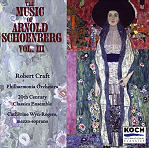No composer in history was more constitutionally incapable of repeating himself than Arnold Schoenberg. If the theory of 12-tone composition states that no single note can be used twice until all the others have appeared first, then Schoenberg applied this concept to whole works. Just take the first decade of the 20th century. Do Gurre-Lieder, Transfigured Night, Pelleas and Melisande, the Chamber Symphony, the Five Pieces for Orchestra, The Book of the Hanging Gardens, and Pierrot Lunaire sound at all alike? And do any of these pieces sound like the Symphonic Variations? You may think you finally understand, even enjoy one of his major works, and move on in happy anticipation to the next, only to find that it’s like learning a new language all over again. For Schoenberg, there was only one way to go: forward into the unknown, time after time, work after work. No wonder he continues to fascinate musicians and terrify audiences, even half a century after his death.
Robert Craft was stimulated by Schoenberg and his Second Viennese School even before his seminal encounters with Stravinsky, and his performances of this music have a unique authority. The Chamber Symphony, one of the most densely argued pieces in history, has never sounded more approachable, largely because Craft’s concern for just intonation, accurate rhythm, and textual clarity make the piece so damn exciting that there’s no time to worry about details like the work’s vertical complexity. It just goes. The same is largely true of the Symphonic Variations, an all but impossible piece that Craft actually makes sound, if not exactly ingratiating, then at least inevitable. Mezzo-soprano Catherine Wyn-Rogers offers alert, finely nuanced readings of the atrociously difficult Op. 22 songs, managing both to shade the text and remain on pitch. Finally, there are the Bach transcriptions: excellent encores to a program that unravels about as far as is humanly possible the enduring artistic paradox that is the music of Arnold Schoenberg. Quite an achievement.
































